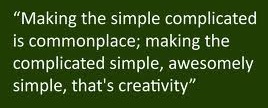 Communication is key to gaining support for an idea or project. The ability to summarize succinctly, to get core concepts across quickly is vital. Think headlines, think bullet points, think the TCC subject-line email message.
Communication is key to gaining support for an idea or project. The ability to summarize succinctly, to get core concepts across quickly is vital. Think headlines, think bullet points, think the TCC subject-line email message.
If you can’t explain a project or goal in a couple of sentences——what the basic idea is or the key concept behind it——then you do not know or understand it very well. You have not grasped its essential nature or why it is important (or not).
If it takes you a whole page to describe something, then you will lose people. Again, think bullet points, headlines, the key points you want your reader to remember.
Closing quote:
(Source: Ezine)
Ten commandments for writing a great lead paragraph. A good lead paragraph must:
1. Summarize: This is the sharp end of your message and the reader must understand what the entire story is about just by reading the first paragraph. The most important and critical information must come first.
2. Answer the five W’s: The who, what, when, where, and why of the story.
3. Grab your attention: Like a good headline, the lead paragraph must grab and hold the attention of the reader.
4. Make every word count: Aim for brevity and word economy. Less is more. Edit out words to increase impact.
5. Make sense: Write for meaning.
6. Be accurate. Always stick to the facts and be truthful, no matter how bad the news. Avoid fluff and hype. Remember it has to be newsworthy.
7. Keep to one sentence: Simplicity is the key to great lead paragraphs.
8. Provide context.
9. Be precise: Precision is vital. Out of all the information you could get across what is the most important? This must be communicated in a precise way.
10. Edit, check and proofread a minimum of 3x: Nothing will shoot your credibility down like a typo or errors! First impressions count; professionalism is essential.


0 Comments